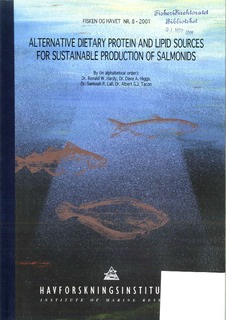| dc.description.abstract | The predicted growth of the salmon farming industry will place increasing demands on global supplies of fishmeal and fish oil, the main constituents of salmon feeds. Alternative sources of protein and lipid exist, but many questions remain to
be resolved concerning their acceptable dietary levels for culturing Atlantic salmon.
In this review, we consider sustainable conventional sources of protein and lipid as
well as those that may be developed in the future. Basic information is needed on
dietary essential amino acid and fatty acid requirements of Atlantic salmon, as well
as information on protein, amino acid and lipid (fatty acid) digestibility, suitable
economical processing methods to enhance the protein concentration and/or reduce the presence of antinutritional factors in some ingredients, and development of feed
formulations that maintain economical growth and health of the fish, and also maintain product quality for the consumer. NORSK SAMMENDRAG: Dersom verdens havbruksproduksjon av fisk og reker fortsetter å vokse vil vi innen få år få mangel på marine oljer og noe lengre fram i tid også få mangel på fiskemel av god kvalitet.
Norges forskningsråd har utarbeidet rapporten "For og formidler - den største utfordringen
for norsk havbruk"(Waagø, Torrissen og Austreng, 2001).
Fórmidler til norsk havbruksnæring er internasjonale handelsvarer der norsk havbruksnæring konkurrerer med annen havbruks- og dyreproduksjon. Havforskningsinstituttet ønsket å få en
internasjonal vinkling på problemet med å skaffe nok fôrråstoff til verdens
havbruksproduksjon som et supplement til Forskningsrådets rapport. Vi ba derfor Dr. Ronald W. Hardy, Dr. Dave A. Higgs, Dr. Santosh P. Lall og Dr. Albert G.J. Tacon om å utarbeide en analyse over behov og tilgang på fôrråstoff for verdens havbruksproduksjon, og også angi mulige alternative, framtidige, fôrråstoff. Rapporten er i sin helhet utarbeidet av forfatterne, og Havforskningsinstituttet er ikke nødvendigvis enige i alle analyser og konklusjoner. Vi mener imidlertid at rapporten gir et viktig innspill i debatten om hvor vi skal finne nye fôrråstoff. Nye fôrråstoff som all
havbruksproduksjon av karnivore og omnivore dyr vil være totalt avhengige av dersom vi
fortsatt ønsker vekst.. | en |
